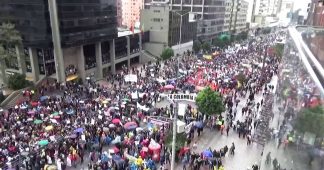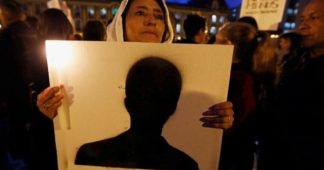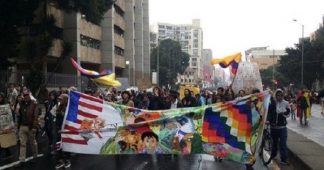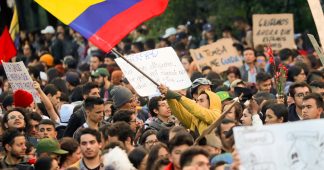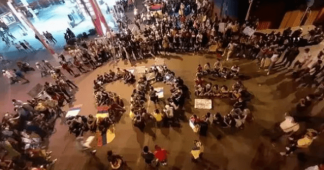June 11, 2021
Colombia’s nationwide strike has gone on for a month now, its mass mobilization reaching historic proportions for the nation and for Latin America. The anti-government protests never cease. This phase of resistance began with a shout of protest against a new policy that would levy taxes on basic products and services, raising the cost of living in a country where unemployment, poverty and inequality are at unprecedented levels. It has now become a struggle between extermination and emancipation.
Even after the Iván Duque government backed off its proposal to tax the “basic family basket,” the demonstrations quickly expanded to include demands by the Colombian people addressing a host of grievances, including the lack of education, employment and health services; constant violence, whether governmental, paramilitary, criminal, patriarchal or racist; government sabotage of the peace process; ongoing executions of rights defenders and social leaders; military occupation of indigenous territories; and, most recently, repression of protesters. Millions risk their lives by participating in the demonstrations, most notably young people, because, as a group of young protesters in the city of Cali told the popular journalist Angélica Peñuela, “Hunger brought us here; we no longer have anything to lose.”
Jhoe Sauca, of the Traditional Authority of the Kokonuco People and the Regional Indigenous Council of Cauca, explains that the tax reform was unacceptable to the Colombian people and became the aggravating factor that finally mobilized millions. “We can’t take it anymore,” he says. “With the pandemic we have been enduring hunger, and our businesses have gone bankrupt, while the government supports the banks and large companies.” He says that the peoples of Colombia have been fighting for 50 years under the principle of unity, and that the reform “has tipped the balance in favor of the message that we have been transmitting to Colombian society — that we must fight for rights.”
He adds, “I think that within this framework, we can raise out organizing capacity at the level of an indigenous movement but also at the society level.” He notes that in 2017 the Social and Community Minga in Defense of Life, Territory, Democracy, Justice and Peace was organized. As it mobilized in their territories, the Minga has brought large contingents to the protests, especially in Cali.
In the same discussion, Vilma Almendra Quiguanás, of the Nasa-Misak people and member of Pueblos en Camino, points out the historic nature of the unity that has been achieved: “Many people from the rural territories are in the movement. According to Indepaz data, of the 1,123 municipalities in the country, 800 have mobilized. We are 15 million in an unprecedented movement. ” She sees the protest as the culmination of 529 years of colonization and resistance, of millennia of patriarchy, and of the false promises and expectations that arose from the Peace Agreement.”
She goes on, “Almost five years after the signing of the Peace Agreement, well yes, development in the ‘inhospitable areas’ has been guaranteed. But what is ‘development?’ It’s mining concessions, oil concessions, expansion of the agricultural boundary, monocultures, water concessions — death projects that are dispossessing, killing and criminalizing the peasantry and popular movements. They deceived us that there would be peace. They deceived us that there would be money. There is neither peace nor money.”
For the Colombian government, its own people are the enemy. The Institute for Development and Peace (Indepaz) documents 71 people killed from the start of the strike to May 31, almost all at the hands of the security forces and allied forces. Approximately 65% of the deaths have been in Cali, “the center of the resistance.” On May 30, a Sunday, the president ordered “maximum deployment of military assistance to the police” in Cali and Popayán. Negotiations with the Strike Committee are going nowhere, as the government insists that the blockades be dismantled as a precondition, without committing to any demilitarization measure of its own. Failed dialogue is not the problem — negotiations have not even formally begun — but rather the lack of political will on the part of the government.
The right wing is increasingly open about its preference for war as a strategy to justify authoritarian control and extermination of the opposition and of large parts of the population. Fernando Londoño, a former minister, put it in the form of a challenge to President Duque: “… if you are not able to deploy the legitimate force of the State to unblock the Port of Buenaventura for better or for worse, you have no choice but to resign.” This is not mere political posturing; the right-wing forces of Álvaro Uribe, the former president who is the power behind the throne, are experts at doing things “for worse.” These days, vicious practices, such as using false positives to execute or criminalize individuals by branding them as terrorists, the reactivation of paramilitaries who never actually demobilized, and selective massacres, are returning. Evidence of paramilitaries and undercover agents shooting protesters in cold-blood abounds on the internet. The use of paramilitary groups and covert operations by the security forces to suppress protests is in direct violation of the Constitution.
Manuel Rozental, a Colombian doctor and also a member of Pueblos en Camino, warns, “If this process of popular uprising allows the Colombian state to massively exterminate people, it will. The question is whether those who say ‘business is business’ will become accomplices even as they claim that it causes them pain.”
The international response to the human rights crisis in Colombia will be a determining factor.
“As long as Joe Biden and the U.S. government do not come out in favor of suspending military aid to the genocidal government of Colombia, they are not only accomplices but much more than that,” Rozental says. “There is no bullet from the police, no gas launched, no policy of repression that has not been financed, promoted and supported by the United States.”
It is worth noting that Biden was the main architect and promoter of Plan Colombia and continues to praise it as a great success of U.S. policy in Latin America.
Rozental emphasizes that the structural causes of the conflict go far beyond the current confrontation between the insurrection and the authorities. Rather, he says, the stage of capitalism has been reached in which the people themselves are a hindrance to the State and to a large part of the business community: “Our history, like the history of capitalism, can be summarized by saying that here there has been exploration by them, then what is useful to them is exploited, then what is left over in the territory of the people is excluded. They end up engaging in extermination because when greed is sacred, stealing and killing is law.” He explains that there is a surplus of population in Colombia that makes it imperative to capture scarce resources.
That the people are considered a nuisance is expressed in the actions of the government. Authorities of the State feel hampered by youth, who are repressed with bullets for protesting the lack of opportunities in a country that ranks among the most unequal in the world, with an official unemployment rate of more than 15% . They feel hampered by defenders of the human rights that the people demand. The Institute for Development and Peace, Indepaz, reports that so far this year alone they have killed 67 human rights defenders who signed the Peace Agreement, making Colombia the number one country in the world in murders of defenders. They feel hampered by the indigenous peoples who seek to protect the natural resources that sustain them and the planet, as well as to protect themselves from dispossession by large companies and the political elite. They feel hampered by women demanding their rights, which have been in sharp decline under the conservative government and the brutal reaffirmation of patriarchy. The idea of peace also seems to bother them — 25 former FARC combatants who signed the Peace Agreement have been assassinated or disappeared this year, sending a clear message that peace is not on the government’s agenda. There have, in fact, been 41 massacres so far this year, leaving 158 victims.
The Colombian people are risking it all in their fight against the neoliberal system of death in their country; they also represent the struggle of all of Latin America. It is a general responsibility not to leave them on their own. A media wall is blocking information about what is happening in this historic mobilization, while the government’s discourse tries to divert attention to the blockades and vandalism, and away from human life and the legitimate demands of the people. Due to the lack of mobility, few journalists have been able to report from the area for the international press and there have been police attacks against those who try. Also, commercial media tends to echo the official versions. Still, massive solidarity campaigns are carried out on social media by the left, feminists, youth and other sectors in all parts of the world. These campaigns have to be bigger, though, and more intense in order to adequately support and protect the demonstrations at this critical time.
Published at www.counterpunch.org
